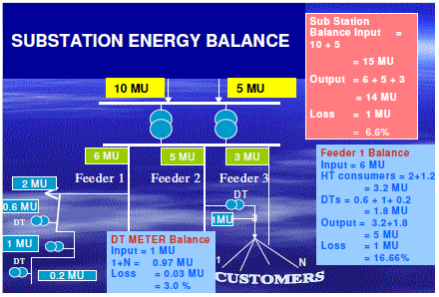Energy losses in loose jump connections, short circuit and earth faults on the lines, service mains and energy meters are assumed to be:
a) 1% of the total energy sent out through the 11 kV line from the substation, for the 11 kV lines of 20 km and more, and
b) 0.5% of the total energy sent out through the 11 kV line from the substation, for the 11 kV lines of less than 20 km.
Energy losses in the feeder = Energy input to the 11 kV feeder - Energy sales
Determining Commercial Losses
The commercial losses are assessed by deducting technical losses from the total losses of the feeder, i.e., the difference between energy sent out and the energy sold. Thus,
Commercial loss in the feeder = Energy loss - Technical loss
The subsequent activities are undertaken to record these losses:
The meter reading schedules of meter readers are revised and made coterminous with distribution transformers. On that day, the distribution transformer meter is also read and comparison is made between distribution transformer meter reading and sum total of consumption recorded in all other consumer meters coming under that distribution transformer. The difference is noted. If the losses are found to be high, action is initiated to trace the installation causing losses.
It is very difficult to get a very accurate picture of these losses due to the subsequent reasons:
1. the energy meters provided on 11 kV feeders are of class 1 / class 0.5 accuracy, whereas at consumer installations the meters are of Class 2 accuracy;
2. all the energy consumed is not recorded due to illegal tapping, theft, pilferage etc.;
3. the sending end readings are taken on a particular day whereas the readings for consumers are taken in a staggered manner;
4. the meter readings of some consumers are not taken due to locked premises/ defective meters;
5. meters are not reading at light load;
6. meters are not recording within prescribed accuracy limits; and
Assessment of consumption in respect of un-metered consumers is missing.

Figure: Determining Technical Losses
Proper and accurate meters, meter reading, meter testing and calibration, billing and collection systems are essential for effective and accurate energy accounting and audit. The meters for energy accounting and audit are termed as system meters which basically are meters at S/S, outgoing feeders, distribution transformers, etc. The role of meters for energy accounting and audit, i.e., system meters is to arrive at operating and performance parameters, energy accounting and energy audit. System meters are generally not used for measuring energy for commercial purposes, and hence need not cater to any tariff structure.
Conducting an effective energy audit will be possible only through a perfect mechanism where the required facilities are available.
Audits will commonly culminate in an energy audit report which must be simply readable and digestible through both technical and non-technical audiences.
We now briefly elaborate what the energy audit report should contain.